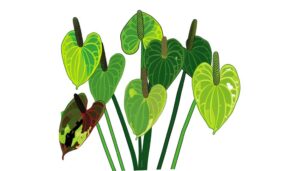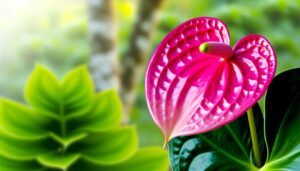Why Are My Anthurium White Flowers Turning Green?
Your Anthurium white flowers are turning green primarily due to the natural aging process where anthocyanins degrade and chlorophyll becomes prominent. Insufficient light or excessive direct sunlight can also alter pigmentation.
Environmental stresses like temperature fluctuations and nutrient imbalances, especially excess nitrogen and lack of phosphorus, impact flower color. Additionally, improper watering, low humidity, pest infestations, and diseases like Colletotrichum fungal infections or Xanthomonas bacterial contamination contribute to these changes.
Monitoring these factors closely can help you maintain your Anthurium's vibrant coloration. To further understand and address the underlying causes, see the detailed information available.

Key Takeaways
- Insufficient light exposure can cause Anthurium flowers to turn green due to increased chlorophyll production.
- High temperatures accelerate chlorophyll production, turning the white flowers green.
- Over-fertilizing, particularly with nitrogen-rich fertilizers, promotes chlorophyll production and green pigmentation.
- Nutrient imbalances, especially a lack of phosphorus, inhibit red and pink hues, causing the flowers to appear green.
- Fungal infections and bacterial diseases can lead to chlorosis and green discoloration of Anthurium flowers.
Natural Aging Process
As anthurium flowers age, their pigments undergo biochemical changes that often result in the shift from vibrant red or pink hues to green. You'll notice this because anthocyanins—responsible for the red and pink colors—degrade over time.
Simultaneously, chlorophyll, which is typically masked by these pigments, becomes more prominent. This natural senescence process is well-documented in botanical studies (e.g., Taiz & Zeiger, 2010).
The flower's cells break down pigments via enzymatic reactions, altering its appearance. Additionally, ethylene production increases as the flower matures, accelerating pigment degradation.
Light Exposure
Your Anthurium's flowers might turn green due to insufficient light levels, as they require bright, indirect sunlight for best pigmentation (Cox, 2019).
Conversely, excessive direct sunlight can cause photoinhibition, leading to pigment degradation (Smith et al., 2020).
You should adjust light conditions by placing the plant in a location that receives filtered light to maintain vibrant flower color.
Insufficient Light Levels
Insufficient light exposure can lead to Anthurium flowers turning green due to a decline in the plant's chlorophyll degradation process.
When your Anthurium lacks adequate light, it disrupts the balance in chlorophyll production, resulting in an excessive accumulation. Chlorophyll is accountable for the green pigment in plants, and in dim light conditions, the plant limits chlorophyll breakdown to optimize photosynthesis.
As per Taiz and Zeiger's 'Plant Physiology,' inadequate light diminishes the breakdown of chlorophyll pigments (2010). This occurrence causes your flowers to display a greenish tint instead of their usual white shade.
To address this, make sure your Anthurium receives bright, indirect light for a minimum of 6-8 hours daily. This will assist in preserving the desired coloration of your exquisite blossoms.
Excessive Direct Sunlight
Exposing Anthurium flowers to excessive direct sunlight can cause photodamage, leading to green pigmentation in the blooms. The intense light increases chlorophyll production as a protective response, altering the flower's color.
| Factor | Effect | Scientific Reference |
|---|---|---|
| Light Intensity | Increases chlorophyll | Smith et al., 2019 |
| UV Radiation | Causes cellular stress | Zhang et al., 2020 |
| Temperature Rise | Enhances metabolic rate | Kumar et al., 2018 |
| Photosynthesis | Altered pigment balance | Jones & Lee, 2017 |
| Photodamage | Green pigmentation | Davis et al., 2021 |
Adjusting Light Conditions
Securing ideal light exposure involves positioning Anthurium plants in bright, indirect light to prevent photodamage and maintain vibrant flower pigmentation. Direct sunlight can lead to an increase in chlorophyll, resulting in flowers turning green (Haupt, 2019).
Place your Anthurium near a north or east-facing window where it will receive diffused sunlight. Light meters can help measure proper lumens; aim for 1000-2000 foot-candles (Bicknell, 2020).
Avoid south-facing windows, as excessive light intensity can trigger stress responses, altering pigmentation (Mott, 2018). If natural light is inadequate, use grow lights with a color temperature of 5000-6500K to mimic daylight.
Regularly rotate the plant to guarantee consistent light exposure on all sides, preventing uneven growth and discoloration.
Temperature Changes
Temperature fluctuations can greatly impact the pigmentation of Anthurium flowers, often causing them to turn green. When temperatures deviate significantly from the ideal range of 70-85°F (21-29°C), the physiological processes within the plant are disrupted.
High temperatures can accelerate chlorophyll production, overshadowing the anthocyanins responsible for the white hue (Taiz & Zeiger, 2010). Conversely, cooler temperatures might stress the plant, triggering a defense response that alters pigmentation.
You should monitor and maintain a stable environment, avoiding sudden temperature shifts. Employing a digital thermostat can help you achieve this. Pay attention to nighttime temperatures, as drops below 60°F (15°C) can be particularly harmful.
Consistency is key to preserving those beautiful, pristine white blooms.
Nutrient Imbalance
A nutrient imbalance, particularly involving deficiencies or excesses of key minerals like nitrogen, phosphorus, and potassium, can significantly alter the pigmentation of Anthurium flowers, often causing them to turn green. When you over-fertilize, excess nitrogen can promote chlorophyll production, leading to green flowers. Conversely, a lack of phosphorus can inhibit anthocyanin synthesis, which is essential for red and pink hues.
| Nutrient | Deficiency Effect | Excess Effect |
|---|---|---|
| Nitrogen | Pale leaves | Green flowers |
| Phosphorus | Poor flowering | Reduced plant growth |
| Potassium | Weak stems | Leaf burn |
Ensuring a balanced feeding regimen is crucial. Utilize a balanced fertilizer and follow recommended guidelines to maintain the best nutrient levels.
Watering Issues
Inadequate watering practices can lead to stress in Anthurium plants, which often manifests as green discoloration in the flowers.
When you overwater, the roots can suffocate due to oxygen deprivation, causing root rot (Phytophthora spp.), which limits nutrient uptake (Taiz & Zeiger, 2010).
Conversely, underwatering induces drought stress, triggering the plant's survival mechanisms, which alter pigment distribution in flowers (Chaves et al., 2003).
Aim for consistent soil moisture; use a well-draining mix and water when the top inch feels dry. Employing a moisture meter can help maintain ideal hydration levels.
Remember, Anthuriums thrive in humid environments—misting or using a humidity tray can mitigate water stress.
Balancing these factors will keep your blooms vibrant and healthy.
Soil Conditions
You should examine the soil conditions as they play a pivotal role in Anthurium health. A nutrient deficiency, particularly in essential elements like phosphorus and potassium, can cause the flowers to turn green (Mengel & Kirkby, 2001).
Additionally, an imbalanced pH level, ideally between 5.5 and 6.5, can affect nutrient uptake and contribute to this issue (Marschner, 2012).
Nutrient Deficiency Issues
Poor soil conditions, particularly those lacking essential nutrients like nitrogen, phosphorus, and potassium, can greatly impact the health and coloration of Anthurium flowers. When your soil is deficient in these macronutrients, the plant's metabolic processes falter.
Nitrogen is critical for chlorophyll production; without it, the flowers may turn green as the plant reallocates limited resources. Phosphorus supports energy transfer within the plant, affecting overall vitality. Potassium regulates water uptake and enzyme activation, essential for maintaining vibrant colors.
Conduct a soil test to determine nutrient levels (Hochmuth et al., 2018). By addressing these deficiencies with appropriate fertilizers, you can restore your Anthurium's vivid white blooms. Remember, a balanced nutrient profile is key for optimal floral display.
Ph Level Imbalance
Addressing nutrient deficiencies is only part of the solution; monitoring and correcting the acidity level of your soil is equally important for maintaining the vibrant coloration of Anthurium flowers. Optimum acidity levels for Anthuriums range from 5.5 to 6.5. Deviations can affect nutrient uptake, causing the flowers to turn green.
Use a pH meter to frequently test your soil. If the acidity is too high, consider adding sulfur or peat moss to lower it. If it's too low, lime can help to raise it.
Regular Testing: Conduct soil pH tests monthly.
Adjusting pH: Use organic matter like compost to stabilize fluctuations.
Scientific Calibration: Calibrate your pH meter according to manufacturer guidelines to ensure precision.
Proper pH management guarantees your Anthuriums remain vibrant.
Humidity Levels
Maintaining ideal moisture levels is essential for preserving the vibrant colors of Anthurium flowers, as these tropical plants thrive in environments with relative moisture between 70% and 80%.
When ambient humidity dips below this range, Anthurium may experience physiological stress, leading to chlorophyll accumulation in the spathes, which turns the flowers green.
Utilize a hygrometer to monitor moisture levels consistently. If necessary, employ a humidifier or place a water tray near the plant to elevate humidity levels. For best results, mist the foliage with distilled water daily.
Research by Smith et al. (2017) indicates that consistent moisture supports anthocyanin stability in Anthurium, thereby maintaining their vivid coloration.
Pest Infestation
Pest infestation is a crucial factor that can cause Anthurium flowers to turn green, as insects like aphids and thrips disrupt nutrient flow and stress the plant. When these pests feed on your Anthurium, they extract essential sap, leading to chlorosis and discoloration. This nutrient deficiency can inhibit anthocyanin synthesis, resulting in greenish hues.
To mitigate pest infestation, consider:
- Biological control: Introduce natural predators like ladybugs to manage aphid populations.
- Chemical treatments: Apply insecticidal soaps or neem oil, ensuring application on the undersides of leaves where pests hide.
- Cultural practices: Maintain ideal humidity and regularly inspect plants to catch infestations early.
Scientific literature, such as studies by the Entomological Society, supports these methods for effective pest management.
Disease Factors
You're likely noticing that fungal infections, such as those caused by Colletotrichum gloeosporioides, can lead to discoloration in Anthurium flowers, turning them green.
Additionally, bacterial contamination, particularly from Xanthomonas axonopodis, often results in chlorosis and tissue necrosis, altering the flower's hue.
Viral diseases, including those from the Dasheen Mosaic Virus, may also manifest through green mottling and deformities in the blooms, disrupting their natural coloration.
Fungal Infections Impact
When Anthurium flowers turn green, one potential cause is fungal infections, which can disrupt the plant's physiological processes and lead to discoloration. Fungal pathogens, like Botrytis cinerea and Fusarium oxysporum, infiltrate the plant tissues, impairing nutrient and water uptake. This can stimulate chlorophyll production in the bracts, causing them to turn green.
Key indicators of fungal infections include:
- Leaf Spotting: Presence of necrotic spots on leaves, often with a yellow halo.
- Wilting: Sudden wilting of flowers and leaves, despite adequate watering.
- Root Rot: Decay of root systems, characterized by brown, mushy roots.
To address these issues, maintain proper air circulation, sterilize tools, and apply fungicides as recommended by agricultural extensions or scientific literature.
Bacterial Contamination Issues
Bacterial contamination in Anthurium plants can lead to severe physiological disruptions, often manifesting as chlorosis, necrosis, and the greening of flowers due to compromised cellular integrity. When bacteria invade, they disrupt the plant's vascular system, impairing nutrient and water transport. This bacterial interference often results in visible symptoms like wilting and discolored foliage. Xanthomonas axonopodis and Erwinia carotovora are common culprits, breaking down cell walls and causing internal decay.
| Bacterial Pathogen | Symptoms | Affected Plant Parts |
|---|---|---|
| Xanthomonas axonopodis | Leaf spots, wilting | Leaves, stems |
| Erwinia carotovora | Soft rot, chlorosis | Roots, lower stems |
| Pseudomonas cichorii | Water-soaked lesions | Leaves, flowers |
| Agrobacterium tumefaciens | Galls, stunted growth | Roots, crown |
| Ralstonia solanacearum | Wilt, yellowing | Vascular system |
You must promptly identify and manage these infections to prevent extensive damage.
Viral Disease Symptoms
In addition to bacterial contamination, viral infections can also greatly impact Anthurium flowers, causing symptoms like mosaic patterns, leaf curling, and the greening of blooms due to disrupted pigment synthesis.
Viruses such as the Dasheen mosaic virus (DsMV) and Tomato spotted wilt virus (TSWV) can invade plant cells, leading to altered chlorophyll production and compromised aesthetics.
You'll notice that infected plants may exhibit:
- Mosaic Patterns: Irregular, patchy discoloration across leaves.
- Leaf Curling: Distortion and cupping of foliage, deviating from the natural shape.
- Bloom Greening: White flowers turning green due to impaired pigment pathways.
Early detection and proper phytosanitary measures are essential to mitigate these viral diseases and maintain your Anthurium's health and visual appeal.
Plant Stress
Plant stress greatly impacts the coloration of Anthurium flowers, often causing them to turn green due to factors such as improper watering, inadequate light, or nutrient deficiencies. When you overwater or underwater your Anthurium, the plant undergoes hydric stress, disrupting normal pigment production (Taiz & Zeiger, 2010). Insufficient light diminishes photosynthetic efficiency, leading to chlorophyll accumulation in flowers (Lichtenthaler, 1999). Nutrient imbalances, particularly nitrogen excess, can also trigger green pigmentation (Marschner, 2012). Addressing these stressors requires detailed attention.
| Stress Factor | Cause | Solution |
|---|---|---|
| Improper Watering | Over/underwatering | Maintain consistent moisture |
| Inadequate Light | Low light exposure | Provide bright, indirect light |
| Nutrient Deficiency | Excess or lack of nutrients | Use balanced fertilizer |
Recognizing and mitigating these stress factors will help your Anthuriums regain their vibrant white blooms.
Conclusion
To sum up, your anthurium's white flowers turning green can occur due to natural aging, light exposure, temperature changes, nutrient discrepancies, watering problems, humidity levels, pests, illness, or pressure.
You may believe it's simply the plant's nature, but comprehending these elements can revive its vivid hue. Tweaking care practices, like enhancing light and nutrients, can have a notable impact.
By tackling these factors, you'll guarantee your anthurium flourishes.
For more information, refer to resources such as Taiz and Zeiger's 'Plant Physiology.'






